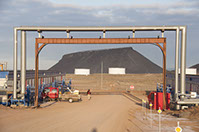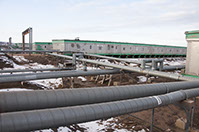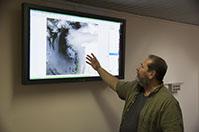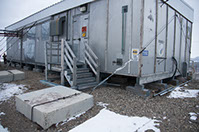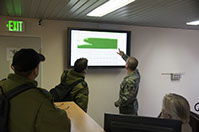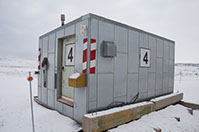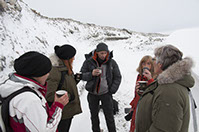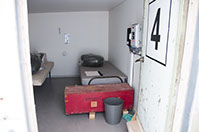
By Patrick Dickson
Stars and Stripes
THULE AIR BASE, Greenland — Legend has it that Eric the Red, father of famed explorer Leif Ericson, gave Greenland its name to attract settlers.
It’s a plausible theory; the island is inhabited in dots along the southern coasts, since the interior is a frozen wasteland.
The vast ice sheet, two miles thick at its peak, stretches for 750 miles to the east coast from Thule, and more than twice that north to south. The big empty. An ice sheet three times the size of Texas. Glaciers spill into fjords along the coast. At Thule, the land slopes down to the base, North Star Bay and Mount Dundas.
The capriciousness of the weather is fascinating and frightening, something all too familiar for base residents.
Winter was fast approaching. As the Earth tilts away from the sun, Thule becomes a land of permanent night, and permanent cold, dipping to as low as 47 below zero, according to base statistics.
“The coldest I saw, during a storm, was minus-60,” 1st Lt. Matthew Smokovitz said. “It gets to a point where you can’t really tell the difference. It’s already cold — who cares at this point?”
High winds, created by low pressure to the west over Baffin Bay, blow in off the ice cap from the southeast. The air is channeled into the valley where Thule is located, increasing the wind speed. According to the base welcome packet, during a storm in March 1972, the anemometer on a storm shelter recorded what is now considered the third highest wind velocity ever: 207 mph.
The welcome packet is probably the only one in the Air Force with this provision: “Storm Condition Delta — All personnel are restricted to the buildings in which they are located at the time a Storm Delta is declared. Absolutely No Pedestrian Or Vehicular Travel Is Permitted.”
Even in good weather, drivers are required to radio in with the number of travelers and destination when leaving the base perimeter, marked with signs rather than a fence.
The changing conditions are of particular interest to the crew at the Ballistic Missile Early Warning System. They are on a mountain where the weather is crazier than down on the base, and they need to be manned 24/7, all year. No exceptions.
Maj. Chris Castle, the operations officer at BMEWS, said the weather can change in an instant.
“When that happens, we have to be pre-positioned to ensure that we can continue operations,” Castle said, “because we can be severed from the main base for three of four days, so we have to keep an eye on the weather.”
Having two crews on site is essential.
“If it takes a turn for the worse, we bring up other folks to augment the ones who are here, send home people who don’t need to be here, and that way people can just rotate in and out here, without having to travel on the road.”
Smokovitz recounted one such day:
“It was the day before or on Thanksgiving, and I got recalled,” he said. “That’s the thing with being on crew; if the weather gets bad or something bad happens, they can call you. You’re basically on six-ring standby; you’ve got six rings to pick up or you’re in some trouble.
“So, all right, pack your bags, quick quick quick, run out to the truck, and by the time we made it up to ‘12 Swiss’ (the 12th Space Warning Squadron) the weather just kept getting worse and worse as we went up the mountain.
“We should have pulled over and gone into the storm shelter,” he said. “I mean, we had the car in first gear; it was barely moving along. We just couldn’t see anything!”
Shelters dot the roads to the radars and North and South Mountains. Each has two beds, some food in a footlocker with a breakable seal, and a phone connected directly to a base operator. Best of all, there is a heater. The heat knocks you back when you open the door.
Predicting the storm
At 947 miles from the North Pole, Thule is closer to Moscow than Washington, and without much land mass upwind, forecasting the weather is more a seat-of-the-pants operation than at just about any U.S. weather station.
Al Hay, 54, is a retired Air Force master sergeant. He has been a polar forecaster for 12 years and has been a contractor at Thule for two years. As the Air Force takes over forecasting at Thule, he’s returning to his roots, forecasting weather on the other side of the Earth — Antarctica. Hay is headed to McMurdo Station this month.
“We’re working here with minimal data. In the States, you have a large network of radars ... whereas up here, you got nothing; you got Baffin Bay. Nothing really local in our area.”
Despite the lack of data, the weather guys must be ready to sound the alarm.
Dave Siebert, 57, who calls Phoenix home, spent 20 years in the Air Force and seven years at Thule.
“We’ve got two main missions here: Resource Protection is going to be the populace of the base as well as the equipment. We have a 30-knot warning for, like, not opening the hangar doors.
“The second one is going to be for the aircraft that comes through. We support anyone, from NASA, Canada, a lot of scientists, Ukraine comes through just for general exercises.”
Tech. Sgt. John Thompson III, 34, had been at Thule for three weeks.
“[Y]ou get into the storm season, the colder season, and [weather forecasters] get into notification of when there may be large storms, or hurricane-force winds, blizzards, whiteouts, things like that, that cause people to be relegated to their dorm, with no movement. You don’t wanna head outside in something like that.”
Some years are bad.
Siebert remembered one year with seven Charlie storms with some going into Delta; other years have one Charlie that lasts a few hours.
Shifting ground
The base sits on permafrost, which is soil at or below freezing. All construction has to be raised so the heat of the building or pipes doesn’t melt the soil and destabilize the structure.
Pipes that cross streets arch over the traffic at 90-degree angles, and the superhighways of pipes between the barracks make for some of the ugliest landscaping imaginable.
When you’re aiming radars thousands of miles out, soil stability is crucial.
Maj. Castle pointed out the cooling towers at the facility.
“To have a large-foundation building, very heavy and very large, especially something that’s producing a lot of heat ... your building can settle and crack and move,” he said.
To cool the ground under these massive radar systems, an intricate cooling system was installed, he said, “which is really counterintuitive: Why would I have to cool something in Greenland? But they have to pump cold Arctic air constantly underneath that to keep it from settling.”

Permanent midnight
In October, the sun arcs low across the southern sky. You lose about a half-hour of light each day. In November, twilight gives way to constant darkness.
“Dark season was a little weird,” Smokovitz said. He arrived in October, working the midnight shift and sleeping during daylight hours until the sun set for good. “It was always dark, and I never saw anybody for months. ... It’s awkward; your body is used to seeing the sunlight; used to seeing people.”
Full-spectrum lighting, which mimics sunlight and is sometimes used in the treatment of seasonal affective disorder, is available in the dorm rooms. Some airmen gave the devices positive reviews, but everyone who’d been through one winter lit up when talking about the sun’s return.
“On Feb. 21, we had the ‘first light’ party. ‘The sun’s out! The sun’s back!’ " Smokovitz said. The higher altitude at BMEWS gave the crew there a glimpse of the sun over the opposing mountains before the people on the main base saw it.
“We always referred to it as ‘hope on the horizon.’”












